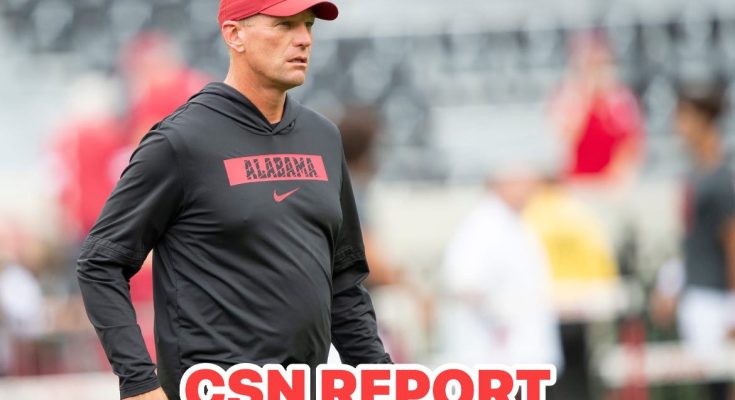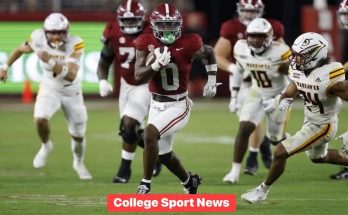When Alabama took the field against the University of Louisiana at Monroe, nobody could have predicted just how dominant the Crimson Tide would be over the course of four quarters. The final scoreboard read 73-0, a lopsided result that not only left fans in awe but also etched its way into the history books. This was Alabama’s largest margin of victory since 1951 and the most points scored in a single game by the program since 1973. In an era where college football is defined by balance, recruiting parity, and the expectation of competitive matchups, a blowout of this magnitude stands out as more than just another victory; it is a statement of where the Crimson Tide stands in college football and how far ahead they remain of certain opponents.
From the opening kickoff, Alabama played with a pace and precision that was unmatched. The offense fired on all cylinders, scoring touchdowns seemingly at will, while the defense suffocated ULM’s attempts to move the ball downfield. By halftime, the score had already spiraled into territory that made it clear history was about to be made. The Tide’s coaching staff emphasized execution, ensuring that the team played clean football despite the disparity in talent. Rather than letting complacency creep in, Alabama pushed harder, focusing on maintaining discipline. This level of effort in a blowout shows why Alabama has been such a consistent powerhouse in the sport for decades.
What makes this performance so noteworthy is not just the raw numbers, but the context surrounding them. College football has changed dramatically since the early 1950s and 1970s. Teams have more access to elite athletes, there is a stronger emphasis on strength and conditioning, and modern offenses are designed to maximize scoring efficiency. For Alabama to produce a result that harkens back to the glory days of the mid-20th century demonstrates not only how talented this roster is but also how well-prepared and motivated they were for this particular matchup. Fans who have followed Alabama for generations immediately understood the historical significance. They have witnessed national championships, Heisman Trophy winners, and countless first-round NFL draft picks, but this type of scoring dominance is something that even long-time supporters seldom see.
The offense deserves much of the credit. Quarterback play was sharp, distributing the ball with accuracy and spreading the defense thin. Running backs exploded through gaps in the line, racking up rushing yards at an almost effortless pace. Wide receivers turned short catches into big gains, showcasing the speed and agility that has become a hallmark of Alabama’s skill position players. Every possession seemed to end in points, and by the end of the third quarter, the game was out of reach by a margin that was nearly unfathomable. Yet, the backups who entered late in the game continued the scoring barrage, proving that Alabama’s depth is as dangerous as its starting unit.
On the defensive side of the ball, Alabama put on a masterclass. ULM struggled to find any rhythm, with the Crimson Tide’s front seven collapsing the pocket and shutting down the run. The secondary played tight coverage, denying any opportunities for big plays. Shutouts at the college level are rare, especially in an age where spread offenses are designed to at least generate some points, even against superior competition. That Alabama not only kept ULM scoreless but also dominated every possession speaks volumes about their preparation and talent. It was a reminder of Alabama’s defensive identity, something that has defined the program under Nick Saban’s leadership and continues to hold strong.
The historical comparisons only magnify the impact of this win. In 1951, Alabama defeated Delta State 89-0, a record-setting blowout that stood as one of the program’s most dominant outings. In 1973, the Crimson Tide scored 77 points against Virginia Tech, marking the last time they surpassed 70 in a game until now. These benchmarks seemed untouchable in the modern age, where competitive balance and scholarship limits are supposed to prevent such wide gaps between programs. Yet Alabama, with its relentless recruiting, disciplined coaching, and culture of excellence, has shown that history can be repeated even in a new era. To align the 2025 roster’s performance with those historic squads speaks to the enduring power of the Crimson Tide tradition.
For ULM, the game will serve as a difficult reminder of the gulf that still exists between college football’s elite and its struggling programs. To be on the receiving end of such a rout is never easy, but it underscores the challenges smaller schools face when scheduled against juggernauts like Alabama. These matchups are often set for financial reasons, with payouts helping smaller athletic departments fund their programs. Yet, on the field, the difference in resources, depth, and talent becomes painfully clear. ULM players will undoubtedly learn from this experience, but the gap remains a reality of college football’s structure.
Alabama fans, meanwhile, will take pride in the statement their team made. A 73-0 victory isn’t just another game; it becomes part of the program’s lore, something that fans will talk about for years. For the players, it is a chance to leave their mark on the history of a school that has already seen countless memorable moments. Being part of a team that scored the most points in over 50 years is an achievement that resonates long after the season ends. For the coaching staff, it is validation of their methods, showing that even in games where the outcome seems predetermined, they can still push their players to perform at the highest level.
The broader implications also matter. College football’s playoff and ranking systems often reward dominant performances, especially when teams are competing for seeding or trying to make a case for inclusion. A 73-0 victory catches the attention of voters, analysts, and committee members who consider strength of schedule, margin of victory, and overall team performance. While Alabama has never had to worry too much about making a case thanks to their reputation and consistent success, results like this further solidify their standing as one of the most feared programs in the country. Opponents take note, and the message is clear: Alabama is not just looking to win games, they are looking to dominate.
From a cultural standpoint, games like this also feed into the mythology of Alabama football. Every great program has its stories that get passed down from one generation of fans to the next. Just as older fans recall the great teams of Bear Bryant’s era or the dominant runs under Nick Saban, today’s fans will remember the day Alabama put up 73 points without allowing a single score. These moments become part of the shared identity of Alabama football, bonding fans together across decades and reinforcing the standard of excellence the program has always demanded.
It is also worth noting the balance Alabama struck between domination and sportsmanship. In blowouts of this nature, criticism can arise if a team is perceived as running up the score unnecessarily. Yet Alabama managed the game in a way that allowed their second- and third-string players to see significant time on the field. The scoring did not stop because the backups executed their plays just as efficiently as the starters. This speaks to the program’s recruiting depth and player development system, where even athletes lower on the depth chart are capable of producing at an elite level. That level of consistency is not just about one game—it is the foundation that sustains Alabama’s dynasty year after year.
For neutral fans, the spectacle of a 73-0 scoreline is both impressive and thought-provoking. It raises questions about competitive balance in college football, the value of non-conference scheduling, and whether games like this ultimately benefit either side. While ULM receives financial benefits, Alabama gains a chance to fine-tune its execution in a game environment that is less stressful than conference play. Still, the sheer dominance puts into perspective how vast the divide can be between the sport’s elite and those fighting to stay competitive.
In the end, Alabama’s 73-0 win over ULM is more than just a number on a scoreboard. It is a snapshot of dominance, history, and the ongoing power of a program that has been the benchmark for college football for decades. It ties the present team to the legendary squads of the past, adds a new chapter to the program’s storied history, and reinforces why Alabama continues to be a measuring stick for greatness. For the players, fans, and coaches, it is a reminder of what is possible when preparation, talent, and tradition come together on the field. And for college football as a whole, it is a moment that underscores the enduring might of the Crimson Tide, proving once again that when Alabama is at its best, few teams in history can match them.



